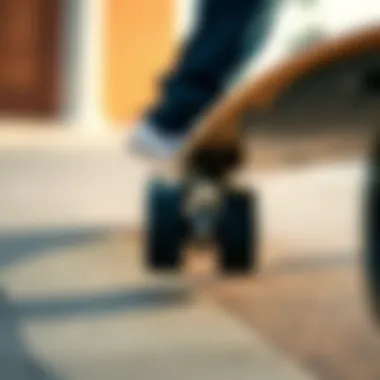Understanding 80A Longboard Wheels: Characteristics and Benefits


Intro
When it comes to skateboarding, choosing the right gear is as crucial as mastering the techniques. Among the many components of a longboard, the wheels stand out as a pivotal factor affecting performance and ride experience. In this article, we take a deep dive into the world of 80A longboard wheels, exploring their unique characteristics, advantages, and best applications.
Wheels come in various durometers, with 80A being a popular choice among riders seeking a balanced combination of grip and softness. The hardness of the wheel plays a significant role in how well it adheres to different surfaces, influencing everything from speed to comfort. Understanding these nuances will equip you not only with knowledge to enhance your riding prowess but also with the ability to make informed decisions about your longboard setup.
Skateboarding Techniques
Mastering the Basics
Before you hit the streets or parks, it’s essential to brush up on fundamental techniques. Riding skills are enhanced significantly by the choice of wheels under your board. The 80A durometer provides a softer ride, allowing beginners to gain confidence on varied terrains. This softness can help absorb shocks, granting a smoother experience on rough surfaces which is particularly beneficial for novice riders who might find harder wheels uncomfortable.
When starting out, here are some fundamental techniques to focus on:
- Pushing Off: Find your dominant foot and practice pushing off to gain momentum. An 80A wheel will help you maintain a steady grip, reducing the risk of slipping.
- Carving: Learn to lean into your turns. Softer wheels offer better grip and control, allowing for smoother transitions.
- Braking: Develop a braking technique using your back foot. Softer wheels can provide a more comfortable and controlled stop.
Advanced Tricks and Stunts
Once you've nailed the basics, it’s time to elevate your skills. More experienced riders may utilize the characteristics of 80A wheels for various tricks. While you can perform stunts on harder wheels, softer wheels can help with grip during tricks like slides and spins. This stickiness can make all the difference when balancing during complex maneuvers.
To enhance your trick performance:
- Sliding Techniques: Use the grip of 80A wheels to control your slides, letting you experiment with various styles safely.
- Jumping and Tricks: The softer wheels absorb landings better, making them ideal for jumps and flips. This can increase your comfort level when experimenting with heights.
Remember: Experimenting with different techniques on diverse surfaces is key. The right wheel choice helps minimize the chances of wipeouts and boosts your confidence.
Gear and Equipment
Skateboard Types and Features
Not all skateboards are created equal, and the type of board can dictate your riding experience. For instance, longboards are typically tailored for cruising and downhill rides, while shorter boards might cater to tricks and skate parks. When paired with 80A wheels, they can provide a versatile ride suited for both leisurely trails and urban landscapes.
Some popular types include:
- Cruiser Boards: Ideal for smooth rides over longer distances. Combining these boards with 80A wheels can lead to effortless maneuvers.
- Freeride Boards: Designed for more technical riding, the softer wheels allow for a greater flexibility when tackling trick dynamics.
Essential Safety Gear
While perfecting your skills and choosing the right setup, don’t overlook safety gear. Protective equipment is paramount to ensure safety as you master new abilities. Essential gear includes:
- Helmets: A must-have for protection against falls. Make sure it fits snugly.
- Wrist Guards: These can prevent injuries during falls, especially in the learning phase.
- Knee and Elbow Pads: Soft wheels may prevent some tumbles, but protective gear will safeguard against scrapes and bruises.
As you embark on your longboarding journey with 80A wheels, remember that knowledge equips you for better riding experiences and safety. Stay informed, practice regularly, and enjoy the ride!
Foreword to Longboard Wheels
When you’re cruising down the street, gliding effortlessly on a longboard, have you ever paused to consider what makes that ride so smooth? Longboard wheels play a vital role in shaping the overall riding experience, influencing everything from speed to stability. They are not just rubber circles; they’re carefully designed components that directly affect how a longboard performs across various terrains.
Understanding longboard wheels is crucial, especially for those who are just stepping into the world of skateboarding or looking to upgrade their gear. Each aspect of a wheel, including its shape, size, and material, holds a purpose. Have you ever noticed how a well-rounded wheel allows you to navigate bumpy sidewalks while a grippier option helps you take sharp turns on smooth pavement? Being aware of these differences can make all the difference in achieving that perfect ride.
Defining Longboard Wheels
Longboard wheels come in various shapes and sizes, and they have two primary features that are essential to their performance—the durometer and the diameter.
- Durometer refers to the hardness of the wheel and is measured on a scale. Typically, longboard wheels range from 78A to 101A, with 80A wheels sitting comfortably in the middle. A softer wheel (like 78A) offers smoother rides, while harder wheels (like 101A) excel at speed and sliding.
- Diameter speaks to the size of the wheel, measured in millimeters. Larger wheels provide better rolling over bumps while smaller wheels allow for more maneuverability.
For longboarders, choosing the right wheel can feel like finding a needle in a haystack. The options can be overwhelming, and the right choice can often depend on where and how you plan to ride.
Importance of Wheel Durometer
The durometer of a longboard wheel isn’t just a number; it’s an indication of how the wheel interacts with the ground and impacts the rider. Choosing a wheel with the right durometer affects:
- Grip: Softer wheels (like 80A) conform better to the surface, enhancing traction. This is crucial for safety when taking turns at speed.
- Ride Quality: The way a wheel absorbs shocks from bumps varies drastically based on its hardness. Softer wheels cushion the impact better, leading to a more comfortable ride.
- Longevity: Softer wheels wear down faster than harder ones. If you’re riding on rough surfaces frequently, you might find that those cushy wheels are good for a short term but may require replacement sooner.
In short, understanding durometer is key to achieving the desired balance of performance and comfort. Consider your riding style and the surfaces you’ll be cruising over before making a purchase.


"Choosing the right durometer is like picking the right pair of shoes. If they don’t fit well, every step can feel like a chore."
So, let’s dive deeper and explore the specifics of 80A longboard wheels in the upcoming sections, bringing clarity to what they offer and why they could be the right fit for your longboarding endeavors.
Understanding 80A Durometer
When discussing longboard wheels, one cannot overlook the significance of wheel durometer, particularly the 80A rating. Understanding this durometer helps riders make smarter choices based on their needs and riding style. Essentially, durometer measures the firmness of the wheel, significantly influencing the overall performance of a longboard. This section will dive into what 80A specifically means and how it stacks up against other durometers in the longboarding world.
What Does 80A Mean?
The term 80A refers to shore durometer, which is a system that quantifies how hard or soft a material is. In this case, it’s the hardness of the wheel made out of urethane or other similar materials. An 80A wheel is considered soft, providing a certain flexibility that enhances grip and cushioning.
- Grip: Soft wheels like the 80A offer better traction on various surfaces. This is particularly beneficial in urban environments where rough pavement can be common.
- Comfort: The flexibility in the 80A allows for an improved ride quality, enabling riders to tackle uneven terrain with ease, thus reducing vibrations that might otherwise cause discomfort.
- Durability: While generally softer, materials like urethane remain resilient. The 80A wheels balance performance with durability, making them a preferred choice for casual riders and those who want to combine comfort with sufficient longevity.
Overall, if you’re keen on cruising around the city streets, 80A wheels might be just what you need.
Comparison with Other Durometers
When looking at wheel durometers, one often needs to compare different ratings to grasp their specific advantages and applications. Let’s look at how 80A stacks up against other common durometers:
- 78A Wheels: These are softer than 80A, and while they provide even more grip and comfort, they tend to wear down faster. Ideal for those who prioritize cushioning over longevity, 78A wheels might be perfect for those smooth, well-maintained skateparks, but might not hold up as well on rougher surfaces.
- 82A Wheels: A notch harder than 80A, these wheels provide a smoother, faster ride, perfect for going down hills. However, they may sacrifice some grip compared to their 80A counterparts. Riders seeking speed with decent grip often choose 82A for that extra edge on smoother pavement.
In summary, while 80A wheels offer a good balance between softness and durability, the choice between these durometers ultimately boils down to individual riding preferences and conditions. As with anything concerning longboards, being aware of the specs helps in tailoring your setup for the ultimate experience.
"Choosing the right wheel durometer can make or break your ride. Be smart about it!"
By understanding what 80A means and how it compares to other durometers, riders can make informed choices that resonate with their longboarding style. It ensures that each individual, from casual cruisers to enthusiastic downhill riders, finds a perfect fit that aligns with their specific needs.
Materials Used in 80A Wheels
The materials that go into 80A longboard wheels play a pivotal role in determining their performance and overall quality. When riders choose their wheels, they are not just picking a piece of plastic; they are selecting a vital component that will affect their glide, grip, and enjoyment on the board. Understanding the materials helps not only in making smarter buying choices but also in appreciating the engineering that goes into creating these wheels.
Common Material Types
When it comes to 80A longboard wheels, the material primarily used is urethane. This synthetic compound is favored in the industry due to its unique properties that cater to comfort and performance.
- Urethane:
- Polyurethane (PU): This is another common choice and is often used interchangeably with urethane wheels. However, PU may contain additives to enhance performance further.
- Rubber: Though less common in 80A wheels, rubber materials can occasionally be found.
- Known for its durability, urethane wheels resist abrasions and can withstand various road conditions.
- They come in various colors and designs, allowing for personalization while retaining functionality.
- Urethane provides a good mix of hardness and softness, which translates to an ideal ride for cruising and commuting.
- It generally offers better grip on slick surfaces.
- Variations can be designed to improve rolling efficiency.
- They generally provide a softer ride but often lack the durability and speed of urethane wheels.
Impact on Performance
The choice of material not only dictates how a wheel looks but has a profound effect on its performance in multiple contexts. Here’s a closer look at how the specific materials influence the performance of 80A wheels:
- Grip: The stickiness of urethane helps riders maintain better control, especially on sharp turns. This grip is crucial for downhill or freestyle riding where stability is paramount.
- Durability: Longer-lasting wheels improve the overall cost-effectiveness of owning a longboard by allowing for extended use without needing frequent replacements.
- Smoothness: Urethane’s ability to absorb shocks means that riders experience a less jarring ride over rough surfaces, translating into enhanced comfort during longer rides.
- Speed: The hardness of the wheel also plays a role; 80A wheels can roll faster than softer wheels but still provide the cushioned feel required for cruising.
"Material choice is fundamental in achieving the right balance between speed and control for an ideal riding experience."
Benefits of 80A Longboard Wheels
When it comes to the excitement of longboarding, the wheels play a crucial role. The benefits offered by 80A longboard wheels are indispensable. For both the seasoned rider and budding enthusiasts, understanding these advantages can elevate the longboarding experience. 80A wheels strike a balance between softness and durability, making them a preferred choice for various riding styles. Let’s break down some of these core benefits that stand out.
Enhanced Grip
One of the primary attributes of 80A wheels is their enhanced grip. This is due to their softer durometer, which allows the wheels to conform to rough terrain, providing more contact with the ground. For riders navigating uneven surfaces, such as city streets or gravel paths, the native grip of these wheels vastly improves stability. This is especially pertinent for beginners, as it fosters confidence when tackling corners or sudden turns. In fact, a lot of riders find that softer wheels can help in reducing slips and accidents, making 80A wheels a smart pick.
Smoother Ride on Rough Surfaces
Another benefit of 80A longboard wheels is the ability to deliver a smoother ride, particularly on rough surfaces. Thanks to their softness, these wheels can absorb vibrations and minor bumps that would typically rattle harder wheels. It's like sailing on calm waters compared to battling a choppy sea. Whether rolling over cracks in the sidewalk or venturing onto less than perfect terrain, 80A wheels promise a more enjoyable and comfortable ride. Riders appreciate this characteristic because it allows them to cover longer distances without feeling fatigued by the bumps of the road.
Better Shock Absorption
Shock absorption is critical when it comes to longboarding. 80A wheels excel in this area as well. The inherent flexibility of softer wheels enables them to cushion impacts from drops and uneven pavement. Unlike hard wheels that translate every jolt to the rider, 80A wheels effectively dampen these shocks, resulting in a more forgiving ride. This quality is particularly important for long-distance commuters and freestyle riders who may take more hits while executing tricks. Trying to keep control after hitting a bump is not an easy feat, and riders using 80A wheels often find that they have a better grip on their longboard, allowing for smoother transitions and safer rides.


In summary, 80A longboard wheels combine enhanced grip, a smoother ride over diverse terrains, and superior shock absorption, making them ideal for a variety of riding conditions.
Choosing 80A wheels can significantly enrich one’s overall riding experience, and understanding these benefits should assist both new and experienced riders in making informed decisions about their longboard setup.
Applications of 80A Wheels
When it comes to longboarding, the wheels you choose can fundamentally change the game. In this section, we will dive into the practical applications of 80A wheels, exploring how their distinct characteristics make them suited for different riding scenarios. Understanding these applications is vital for anyone looking to enhance their ride, whether you're a seasoned pro or just starting out.
Cruising and Commuting
For those who enjoy the cruising aspect of longboarding, the 80A wheels are a perfect match. Their softer durometer design ensures that every bump and crack on the pavement is absorbed, providing a nice, smooth ride. This is particularly useful for urban environments where the roads can be filled with imperfections. Riders can glide over cracks and debris without feeling jostled, reducing the risk of a fall caused by sudden bumps.
A key benefit of using 80A wheels in commuting is the increased grip they offer. This grip is especially advantageous when taking tight corners or navigating downhill sections, making them reliable for daily travel.
Freestyle Riding
Freestyle riding is all about creativity and maneuverability. Here, 80A wheels shine by providing an excellent balance between softness and performance. The characteristics of these wheels allow riders to perform tricks and slides with adequate cushioning, minimizing the impact on landings.
Moreover, their grip helps maintain control during complex maneuvers, enabling riders to push their limits without the wheels slipping out from under them. Tricks like spinning or flipping become far more approachable, as skaters can rely on the grip offered by an 80A wheel to stay connected to the board while in motion.
For freestyle riders, the importance of wheel selection cannot be overstated, because even slight differences in durometer can affect trick performance and ride confidence.
Downhill Riding
While some might favor stiffer wheels for downhill riding, the adaptability of 80A wheels shouldn’t be overlooked. These softer wheels provide exceptional traction at high speeds, which is often neglected in discussions about downhill performance. When heading downhill, grip becomes paramount, and 80A wheels provide that security, allowing riders to navigate sharp turns and swift descents with finesse.
Additionally, the shock absorption capabilities of these wheels come into play when tackling terrain that might otherwise cause discomfort. Riders can descend steep hills on rough asphalt, knowing that their wheels will handle the surface variations well.
In summary, the applications of 80A wheels are broad and cater to several riding styles. For the urban commuter, the freestyle rider seeking creativity, or the thrill-seeker heading downhill, these wheels offer the right mix of comfort, grip, and performance. To maximize enjoyment and safety on your longboard, understanding these applications is essential. Riding with the right wheels truly can make all the difference.
"Choosing the right longboard wheel is like picking the right tool for a job; it can either hinder you or enhance your performance."
Further Resources
- Wikipedia on Longboard Wheels
- Britannica on Skateboarding
- Reddit's Longboarding Community
- Facebook Longboarding Groups
Choosing the Right Longboard Wheel
Selecting the correct longboard wheel isn't just a matter of personal taste; it’s a critical aspect that can greatly influence your entire riding experience. The right wheels can enhance performance, safety, and comfort, making it essential for riders—be it a novice or a seasoned pro—to understand what to look for. A good longboard wheel will work with your chosen riding style and the terrain you intend to conquer. This section aims to distill the essence of choosing the right longboard wheel, laying out key elements, advantages, and considerations that every rider should keep in mind.
Factors to Consider
When it comes to choosing a longboard wheel, several factors come into play. Making an informed decision boils down to understanding these elements:
- Durometer Rating: The hardness of the wheel impacts grip and ride quality. For example, an 80A durometer provides a soft yet stable ride, ideal for rough surfaces.
- Wheel Diameter: The size of the wheel affects acceleration and rolling speed. Smaller wheels generally allow for better control, while larger wheels are better for cruising and maintaining speed.
- Material Composition: Look for wheels crafted from high-quality urethane. This material not only affects durability but also how well the wheel grips the surface.
- Contact Patch: A larger contact patch generally increases grip and reduces the likelihood of slipping, which is essential for downhill or freestyle riding.
- Shape of the Wheel: Some wheels have square edges which offer more grip, while round-edged wheels are better for sliding.
Each of these factors plays a vital role in the overall performance and safety of your longboard. Riders should weigh the importance of each based on their unique riding styles and preferences.
Riding Style Matching
Matching your wheel choice to your riding style can make all the difference in your experience. Different riding styles demand distinct qualities from wheels:
- Cruising: If cruising is your jam, 80A wheels could be your best mates. They offer a plush ride, smoothing out bumps and cracks on the pavement. Their grip allows for easy maneuvering on turns, making them perfect for daily commutes.
- Freestyle Riding: For tricks and flips, softer wheels like the 80A provide a stable platform to land on, which can bottom out more comfortably when executing stunts.
- Downhill Riding: While all styles can benefit from the 80A rating, downhill riders often prefer a slightly harder wheel unless their terrain is exceptionally rough. It allows for greater speed with less risk of wheel bite.
- Sliding: If sliding is your goal, a well-sized wheel with the right durometer can help you achieve smooth slides without losing control.
Ultimately, understanding how your chosen wheels will interact with your riding style and the specific conditions you face is key to optimizing your longboarding experience.
"Choosing the right wheel is like picking the right tool for a job; each has its purpose and excels in its area."
Maintenance of Longboard Wheels
Keeping your longboard wheels in top condition is crucial for ensuring an enjoyable and safe ride. Like any piece of equipment, wheels endure wear and tear, and neglecting maintenance can lead not just to reduced performance but also to accidents. Regular maintenance enhances longevity while ensuring optimal performance, making your rides not only smoother but also more enjoyable.
Regular Checks for Wear
Routine inspections should be a part of every longboarder's regimen. Think of it as checking your shoes before a hike—small issues can escalate into significant inconveniences. Here are some key pointers:
- In-depth Inspections: Inspect your wheels often, especially before hitting the trails. Look for uneven wear, chips, and cracks, which can alter how your board acts at high speeds.
- Wobble Check: It’s straightforward yet effective. Take your longboard in hand and give each wheel a gentle shake. If any wobble or play is detectable, it might be time for replacements.
- Axle Conditions: Don’t forget about the axles where the wheels attach. To check their status, take off the wheels and examine for any rust or dirt buildup. A clean axle contributes to smoother spins.
"Just like a car, your longboard needs care. Small, regular checks can save you from noticeable accidents later on."
Cleaning Tips
Maintaining clean wheels not only improves how they perform but also helps extend their lifespan. Dirt and debris can build up, causing reduced grip and unnecessary strain on your ride. To keep your longboard wheels sparkling:
- Use the Right Tools: A soft-bristle brush or rag can do wonders. Avoid hard surfaces that might scratch your wheels.
- Soak and Scrub: If your wheels are particularly grimy, try soaking them in warm, soapy water ( 1-2 tablespoons of dish soap is sufficient). After that, give them a good scrub to remove muck. Rinse well to avoid soap residue.
- Drying: After cleaning, ensure that the wheels are completely dry before reassembling. Any lingering moisture can lead to rust on the axles.
- Periodic Deep Clean: Set a schedule—maybe once a month—where you give your wheels a full spa day. This may look like soaking, scrubbing, and checking all components for wear.


Comparative Analysis with Other Wheels
Understanding how 80A longboard wheels measure up against similar options is crucial for anyone looking to improve their ride, whether they are seasoned skateboarders or newcomers to the scene. This section helps dissect the distinct attributes that set 80A wheels apart from their 78A and 82A counterparts. By exploring these differences, riders will gain valuable insights into how durometers affect performance, grip, and overall ride quality. This comparative analysis not only aids buyers in making well-informed choices but also deepens their comprehension of the mechanics behind longboard wheels, enhancing their overall skating experience.
80A vs. 78A Wheels
When it comes to a duel between 80A and 78A wheels, the variations are subtle yet impactful. Both are known for their softer feel, yet the difference in durometer leads to different experiences on the board.
- Grip: The 78A wheels have a slight edge in terms of grip. They provide a more stick-like sensation against rough surfaces. This can be beneficial for uphill riding or technical tricks, where stability is prized.
- Smoothness: The 80A wheels, while still soft, offer a tad more resilience. This makes them a good choice for cruising rather than downhill racing. They glide over imperfections just a touch smoother than the 78A wheels, which can sometimes feel a bit too squishy when on uneven terrain.
- Wear and Lifespan: If you’re looking into longevity, 80A wheels typically prove to be more durable than 78A wheels. The softer material of 78A wears down faster, especially with aggressive riding styles, making them less suitable for everyday use by casual riders.
Ultimately, the choice comes down to riding style. For those seeking a reliable grip in trick-heavy sessions, 78A might be the route to take. But for a more balanced ride with durability, the 80A wheels could be the sweet spot.
80A vs. 82A Wheels
Now, let’s shed some light on how 80A wheels stand up against the firmer 82A variety. The distinctions here can be pronounced for certain styles of riding.
- Hardness: The 82A wheels are harder, which means they will roll faster and require less effort to get moving. This hardness appeals particularly to downhill riders who value speed and responsiveness. However, that means they sacrifice some grip and comfort.
- Surface Handling: On smooth surfaces, 82A wheels can excel, giving a speedy ride without too much resistance. In contrast, 80A wheels, while not as fast, perform better on uneven surfaces where comfort is important. The softer durometer tends to absorb shocks better, which can help prevent fatigue during long sessions.
- Versatility: In terms of versatility, the 80A wheels often present a more well-rounded option for the average skater. They deliver a decent balance of speed and comfort, making them suitable for both cruising and light downhill rides. The 82A, however, leans more towards performance-focused riding, best suited for those willing to sacrifice comfort for speed.
In the end, each durometer has its own strengths and weaknesses. The clincher? Riders must assess their personal needs. Whether comfort, speed, or grip is the priority will influence the choice between 80A and its neighboring durometers.
"Choosing the right longboard wheel isn't just about specifications. It's about ensuring that the wheel fits into your riding experience seamlessly."
By grasping the nuances between 80A and other options, riders can better navigate their choices, leading to improved performance and enjoyment on their longboard adventures.
Influence of Wheel Size
When discussing longboard wheels, the size of the wheels themselves is a pivotal element that can profoundly influence the overall riding experience. Wheel size impacts not just aesthetic choices but also performance metrics including speed, grip, and control. A longboard outfitted with the right wheel size can make a world of difference, whether you're zipping down a hill or cruising through your neighborhood. In this section, we will explore the nuances of wheel diameter and width, highlighting how each factor plays a role in optimizing your longboarding experience.
Diameter Considerations
The diameter of longboard wheels is measured in millimeters and typically varies between 50mm to over 100mm. Larger wheels, for instance, are known to roll over cracks and debris with ease, while smaller wheels provide a different kind of agility and turn responsiveness. Here’s what you need to keep in mind when selecting the right diameter:
- Rolling Speed: Larger wheels can maintain higher speeds because they cover more ground with each rotation. This is particularly advantageous for downhill riders looking to gain speed swiftly.
- Stability: As the size increases, stability improves, particularly at high speeds. This is essential for long-distance commuting where control is paramount.
- Weight Distribution: Larger wheels can help distribute weight more evenly, which is beneficial for longboarders who prefer carrying gear with them.
However, there are some trade-offs. Larger wheels may feel less responsive in tight turns, as they tend to have a larger turning radius. If you favor frequent city cruising or performing tricks, smaller wheels might be more suited for your style. Keep these factors in mind and consider your primary longboarding activities when choosing wheel diameter, as they define how you connect with your board and the ground beneath you.
Width of the Wheel
Width, typically gauged in millimeters, is critical in determining both grip and overall handling characteristics of your longboard. The relationship between width and performance is somewhat straightforward:
- Grip and Traction: Wider wheels often provide better contact with the surface, resulting in enhanced grip. This is especially beneficial for riders who favor aggressive carving or those riding on slick surfaces.
- Balance: A wider wheel can help in achieving greater stability, especially for heavier riders or when carrying additional gear. This results in a more balanced ride, reducing the likelihood of wobbling during high-speed descents.
- Versatility: If you're a rider who transitions between various styles—be it freestyle, cruising, or downhill—wider wheels offer versatility. They adapt well to different surfaces and riding conditions.
As a thumb rule, think about how you ride and where you ride. A wider wheel increases your options but can slow you down due to extra friction—it's a balancing act worth careful thought.
Choosing the right width always requires a bit of soul-searching into your riding style, making sure that the wheels you pick align with the adventures you'll undertake. By understanding the significance of both diameter and width, you're better poised to tailor your longboarding setup to suit your specific needs and aspirations.
Future Trends in Longboard Wheels
The landscape of longboard wheels is continually evolving, shaped by advancements in technology and the ever-changing demands of riders. Understanding the future trends in longboard wheels is not just interesting—it's crucial for anyone involved in the sport, from casual riders to competitive skateboarders. Staying abreast of these trends ensures that you are equipped with the best gear, maximizing enjoyment and safety.
Innovations in Materials
The materials used in longboard wheels have come a long way. For instance, traditional urethane remains a staple due to its durability and grip. However, manufacturers are increasingly experimenting with hybrid materials that blend resilience with lighter weights. Graphene-infused polyurethane is one example. This cutting-edge material enhances performance by providing greater flexibility while maintaining hardness.
Another promising innovation involves the incorporation of biodegradable materials, aligned with increasing environmental awareness. Some brands are developing wheels made from sustainable resources that don’t sacrifice performance but contribute positively to the planet.
Benefits of these innovations include:
- Improved Durability: Wheels that can withstand wear and tear over time help in reducing costs in the long run.
- Enhanced Performance: Sophisticated materials can lead to better speed and handling, giving riders a smoother experience.
Technological Advances in Design
Design technology is not just limited to aesthetics; it plays a vital role in how wheels perform. As manufacturers embrace 3D printing, they can prototype and test designs more rapidly than traditional methods. This allows for the creation of wheels that cater specifically to different riding styles, whether it be downhill racing or casual cruising.
One notable trend is the development of asymmetric wheel designs. These wheels feature differing shapes or durometer levels on each side, optimizing performance for various conditions. Such designs can enhance grip on sharp corners while ensuring speed on straight paths.
Moreover, advances in computer-aided design (CAD) systems enable more precise calculations of dimensions and force distribution, resulting in wheels that are tailored for optimal performance.
In summary, the future of longboard wheels is shaped by innovative materials and cutting-edge designs that promise to enhance the overall riding experience. Whether you are looking for durability, performance, or sustainability, staying informed about these trends can significantly impact your longboarding journey.
"Understanding advancements in wheel technology and materials is just as important as knowing how to ride itself."
For those looking to explore more about longboard wheels and technologies, sites like Wikipedia and Reddit are good sources for community insights and updates.















